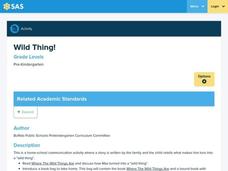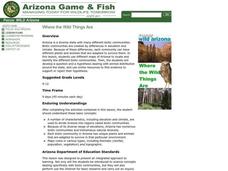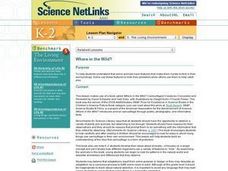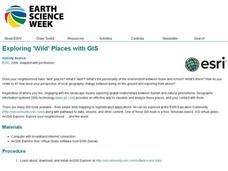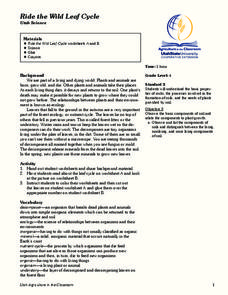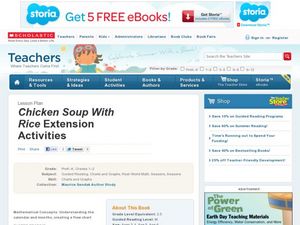Curated OER
Texture: Wild Things
Students experiment with different kinds of marking techniques. They read "Where the Wild Things Are" and observe animals for pattern and line. They compare illustrations with Haring's images. They create a symbolic drawing of animal.
Curated OER
Maurice Sendak's Books: More Relevant and Rigorous than Ever
Nearly 50 years after publication, Sendak's Where the Wild Things Are holds up to the Common Core.
Curated OER
Wild Thing!
Students read Where the Wild Things Are. In this language arts lesson, students read the story and retell the story. Students tell a version of the story in which they turn themselves into wild things.
Curated OER
Wild Things Are Here
Students engage in a literature study for the book Where The Wild Things Are. The skill of prediction is practiced as they preview the story as a whole class. The teacher models reading fluency, pronunciation, and phonetic skills while...
Curated OER
Where the Wild Things Are
Pupils examine the characteristics that divide Arizona into different regions. In this resources lesson students complete a worksheet on the biotic communities Arizona has.
Curated OER
Monsters are Make-Believe
Students decide if items are real or make-believe. For this lesson on reality, students listen to the book Where the Wild Things Are by Maurice Sendak and discuss the difference between items that are real and items that are make-believe.
Curated OER
What's Wild
Third graders discover the differences between wild and domestic animals. In this animal lesson, 3rd graders chart the differences in the animals and look through magazines for pictures of wild and domestic animals to glue to a poster....
Curated OER
Third Person Point of View
Have your class practice determining whose point of view is being utilized throughout the course of a story. They begin by working as a class to create a chart which will provide textual examples that describe first and third person...
Curated OER
Where in the Wild?
Students investigate the purpose of animals' ability to camouflage. In this animal science lesson, students read the text Where in the Wild? and identify animals that are predators and prey. Students discuss how camouflage is necessary...
Curated OER
Thumbs Up For Expert Readers!
Students use the cross check strategy to increase reading comprehension in this lesson. They listen as the teacher reads "Where the Wild Things Are." The teacher purposely reads some words wrong so that the story does not make sense. ...
Curated OER
Map Making
Students examine a variety of strategies to identify the structure of a story. They listen to the book Where the Wild Things Are and, as a class, complete a story element chart. Students independently read a passage from Charlotte's...
Montana Natural History Center
Studying Grassland Ecosystems
At first glance, grassland ecosystems might seem dull and uninteresting, but once you start to explore it's amazing the things you'll find! Through this series of engaging lessons, activities, and experiments, elementary students examine...
Curated OER
Beginning, Middle and Ending
First graders identify the beginning, middle and ending of the story "Where the Wild Things Are". They also listen to different songs and identify the beginning, middle and ending. They create their own story and identify the different...
Curated OER
Exploring 'Wild' Places With GIS
Young scholars explore "wild" places. In this technology lesson students use ArcGIS Explorer to investigate wild places near them in their neighborhood. Young scholars view the landscape from both above and the ground.
Curated OER
Writing: Mentor Text Lesson & Microteaching
Mentor texts are a great way to demonstrate how to write with purpose. Pupils will be reintroduced to two well-known books and then asked to think about them from the writer's point of view. They will see that the author had to use basic...
Science Matters
Island Fox Outreach
Off the coast of California lives a wild animal called the Island Fox. Experts discuss the importance of the Island Fox to the Channel Islands and the balance the fox creates within its ecosystem. The lesson concludes with a reading of...
Curated OER
Ride the Wild Leaf Cycle
Fourth graders complete a worksheet. In this life cycle lesson, 4th graders learn about the leaf cycle and complete a worksheet where they put the leaf cycle steps in the correct order.
Curated OER
Reading Faster with Wild Thing
Students practice one-minute oral readings to increase their speed and fluency. They review several reading strategies, and then they read orally with a partner. The partner times their reading with a stopwatch and tracks their time on...
Curated OER
Comprehending Through Questioning
Elementary schoolers observe and apply a variety of reading comprehension strategies. They silently read a passage out of their science textbook, and discuss answering the who, what, where, when, and how of the text. In small groups they...
Curated OER
Chicken Soup with Rice Extension Activities
After reading Chicken Soup with Rice, by Maurice Sendak, incorporate some of these great extension activities into your lesson plan. Ideas include focusing on knowing the months of the year, or studying the illustrations and how...
Curated OER
The Celts
Look far back in history and you'll meet a people group called the Celts. Celts, as you'll soon find out, are a group of people who inhabited Britain 2000 years ago. Presented here, is simple information which describes a bit about...
K5 Learning
Humming Birds
Seeing a hummingbird in the wild can be a magical experience. Learn more about these delicate members of the animal kingdom with a short reading passage, complete with four short-answer questions.
Curated OER
Stories Aren't Always What They Seem; Or Are They?
Students draw conclusions about a story with examples to support their statements. In this reading comprehension lesson, students look at a PowerPoint of a variety of passages from different books. They answer questions about the...
Curated OER
What's Wild?
Third graders define domesticated animal and wildlife. In this animal lesson, 3rd graders cut pictures out of magazines of both types of animals and make two collages with the pictures.




